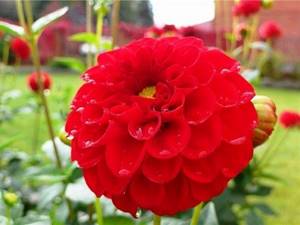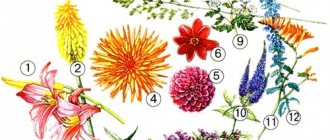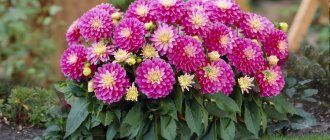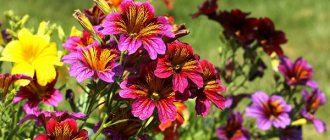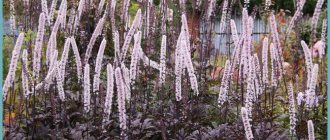Large dahlias attract the attention of many gardeners, and this has a fairly simple explanation. These plants are not only very beautiful, they are among the most effective in terms of commercial cultivation. Large dahlias are relatively easy to grow and propagate; they can last quite a long time in a cut or bouquet. In addition, growing dahlias does not require such painstaking preparation and great labor intensity as growing roses or peonies. Thanks to breeding work, dozens of new varieties of dahlias appear every year, among which the proportion of large-flowered plants is only increasing.
The best varieties of dahlias with large flowers
Below are the most popular dahlias with large flowers that can be successfully grown in our country. For each variety, not only external features will be indicated, but also some secrets of its cultivation.
The Dana variety (or Dahlia Dana) is considered one of the largest among dahlias. The spectacular appearance of the huge inflorescence will not leave almost anyone indifferent.
Dana's petals are needle-shaped and red-yellow in color.
- bush height from 90 cm to 1.2 m;
- flower diameter – 25-27 cm;
- flowering lasts from the first ten days of July to the second ten days of September.
This is an annual plant that does not tolerate frost well. After flowering has ended, it is necessary to dig up its rhizome and, after washing and drying it, place it for storage in a place with a temperature of + 2-5 ° C.
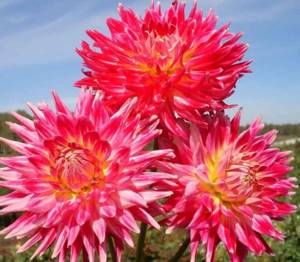
Feature of the plant: planting must be done in the second ten days of May. Prefers clay soils and loams. The recommended planting pattern is 0.7 by 0.9 m. Feeding is required (at least 3 per season).
Vancouver
A distinctive feature of the variety is a double flower, which looks very similar to a chrysanthemum. The plant is very decorative due to the structure of the flower and the original colors.
- the color is wine-red, in rare cases red-violet, with a white or white-yellow edging along the edges of the petals;
- height of peduncles – from 70 to 110 cm;
- flower diameter – 25-26 cm;
- flowering lasts from the first ten days of July to the third ten days of September.

Vancouver is distinguished by abundant flowering, and the bush has a very lush appearance. The stems of Vancouver are quite strong, they do not need support, although many gardeners still recommend using it.
The plant can be grown both in groups and in single plantings. Prefers soft and loose soil and grows best in sunny conditions.
In the fall, the rhizome is dug up, cleaned and stored under conditions similar to the storage conditions of Dana.
Kelvin
The official name of the variety is Kelvin Floodlight. This plant is considered to be the largest dahlia. It is very popular among flower growers. At numerous dahlia competitions, the Kelvin variety has been awarded a large number of awards.
- yellow color with slight hints of green;
- height of peduncles – from 90 cm to 1.3 m;
- diameter of the flower part – more than 30 cm;
- beginning of flowering - the first ten days of July;
- Flowering duration is up to 4 months.
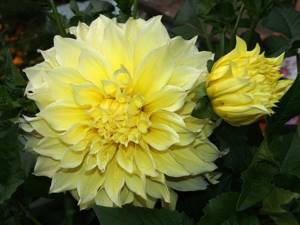
The petals in the central part of the flower have a tubular shape; closer to the outer edge they straighten, becoming slightly pointed.
The plant needs regular feeding and removal of excess buds.
In addition, when growing, you need to constantly monitor the side shoots, removing excess ones.
Striped Emory Paul
Also one of the largest varieties. Bred in Holland. It has feathery leaves covering the stems in large numbers. The petals of the flower are flat and quite wide. They have pointed ends.
- color: pink or purple-pink;
- height of peduncles – up to 110 cm;
- flower diameter – 27-30 cm;
- beginning of flowering - end of June;
- Flowering duration is up to 4 months.

Lush growth requires well-drained soil in a sunny position. Peduncles do not require supports. The plant has increased resistance to pests and diseases.
Similar to the previously discussed varieties, it requires digging up for the winter for further storage. Recommended storage conditions: temperature from + 3 ° C to + 7 ° C, humidity no more than 50%. They reproduce by dividing the tuber in the spring.
Perfection
A group of varieties, the most famous of which is Lavender Perfection. Within a group, plants have approximately the same flower structure (it is densely double with two types of petals), but the colors of the petals can be very diverse.
- bush height: from 110 to 130 cm;
- diameter of the flower part – up to 30 cm;
- the number of inflorescences on one bush is up to 25;
- colors: from solid snow-white to purple, pink, yellow, etc.;
- varieties with multi-color combinations are often found (for example, Gitts Perfection);
- flowering occurs from mid-July to the end of September.
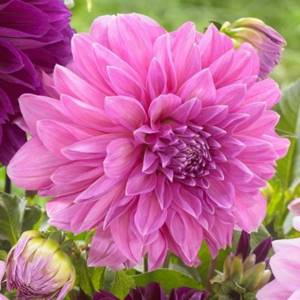
A distinctive feature of the Perfection variety is the absolute unpretentiousness of the plant and the minimum required care. This variety can grow in almost any soil and has good resistance to diseases and pests.
Akita
The variety was developed in Japan about 40 years ago. It is highly decorative. Perfectly suitable for growing in Russia. Has good resistance to weather conditions.
- height of peduncles – up to 95 cm;
- flower diameter 23-25 cm;
- color: rich red, with yellow edging around the perimeter;
- flowering: from July to September.

Loves fertile soils and fertilizing. On poor soils it rarely reaches a height of even 70 cm. Feeding should be regular and include at least 5-6 per season.
It is believed that Akita tubers can survive wintering in the ground, but this is recommended only in the southern regions.
Non-double or single row
The peculiarity of this group is that the petals are arranged in 1 row. The circumference of the buds does not exceed 10 cm. The height of the bushes is up to 0.5 m. Reproduction of this species occurs with the help of seeds.

The most common varieties:
— Happy Kiss. This variety with orange buds 4-5 cm in circumference was bred by Dutch breeders.
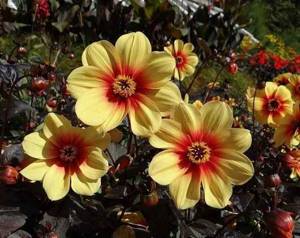
- Funny boys. The height of the stem is no more than 40-50 cm. The balls are not double, up to 9 cm in circumference, with a yellowish tint.

Dahlias are popular flowers and there are many different types and varieties available. You can look at the pictures, study the description and choose those varieties that will fit perfectly into the landscape design of your garden.
Features of growing large-flowered dahlias
Large-flowered dahlias have certain peculiarities when growing, which consist of performing procedures that, when growing ordinary plants, may seem strange or even somewhat barbaric.
But one should not be surprised by this method of handling flowers, since almost all of the procedures considered aim to direct the maximum part of the energy received by the plant to the formation of huge flowers. And here gardeners take into account almost all factors affecting the quality of the resulting material.
Removing excess vegetation and flowers
Features begin already at the stage of selecting dahlia tubers. You should choose larger tubers, but with a small number of sprouts. Too many sprouts means too many stems and therefore smaller flowers. Therefore, no more than 3-4 sprouts are left on the tubers and they begin to germinate in this form.
At the stage of seedling germination, new shoots may appear; they also need to be removed, leaving no more than 3 flower stems in the “adult” plant state.
As the plant grows, it is necessary to remove the lower leaves from the shoots (located at a height of 25-30 cm and below). This procedure is carried out on all shoots, its goal is to provide maximum warmth and sunlight to the root system of the plant.
Simultaneously with the removal of the lower leaves, large dahlias are pinched. In this case, all side shoots are removed. Also, no more than 3 buds are left on the stem.
Thus, everything unnecessary will be removed from the plant’s metabolism, which interferes with the formation of beautiful huge flowers.
Removing emerging seed material
After the flowers fade, they must be removed, since the formation of already set seeds will require additional nutrition. In this situation, this is even beneficial for the plant, since the formation of seeds begins to consume nutrient reserves from all sources, including from tubers.
Propagation of dahlias
Dahlia propagates vegetatively, except for non-double varieties, the so-called cheerful guys, which, as a rule, are propagated by seeds.
The main methods of vegetative propagation of dahlia are dividing the root tuber and cuttings. From mid-March, young healthy tubers are transferred from storage to a warm, bright room for germination. Before this, all damaged parts of the tuber are removed and kept for 10-15 minutes in a 0.2% solution of potassium permanganate.
Dahlia tubers are planted in boxes and sprinkled with light sandy soil. At the same time, make sure that the root collar is open and the soil is moist. After 7-10 days, when the eyes reach a size of 1-1.5 cm, division can be carried out. Depending on the size and number of awakened eyes, the root tuber is cut into 3-6 parts. Each separated part should have a piece of the root collar and at least one eye. The cuttings are planted in boxes or pots so as not to cover the cut site of the root collar. Dividing root tubers rejuvenates them.
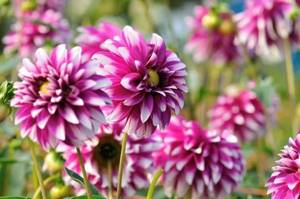
Description
Dahlias planted near the house look impressive. Height - 0.5-2 m. The leaves are large, dissected, oblong in shape. Baskets of inflorescences of various shades, beautiful shapes, with petals in several rows or simple.
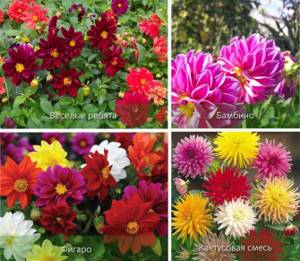
The petals vary depending on the group of dahlias. Tubular flowers predominate in the core, with ligulate flowers up to 40 cm along the edge. Blooms from June to October. The bushes are powerful. They have root tubers. Every year, restoration buds form on the root collar. In temperate and cold climates they are dug up.
Brief description of the genus
Dahlia, also known as Dahlia, came to Russia from Mexico. It received both of its names in honor of famous biologists - Dahl and Georg, who studied and described its varieties.
In the botanical classification, dahlias belong to the Asteraceae family. They are divided into approximately 40 species, and, according to various estimates, there are from 10 to 15 thousand varieties. Moreover, every year more and more new varieties of dahlias appear.
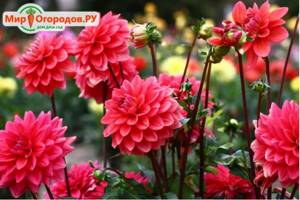
The secret of the beauty of dahlias is in the unusual structure of the inflorescences. Their baskets consist of several types of flowers, which can be directed in different directions:
- Marginal petals (rolled inward, outward, or flat);
- Collared tubular flowers;
- Tubular flowers of the core (open or in the form of unopened buds).
By influencing the number or presence of a particular type of flower, breeders can easily obtain new and different varieties of dahlias.
Dahlias are often called tuberous plants, and their root system is called tubers. But it would be more correct to call them root tubers. Tubers are modified shoots with thickened stems that are located in the ground. And dahlia root tubers, also called root cones, are thickened roots.
In the literature, two variants of the name of this flower are used - dahlia or dahlia, apparently, it was not possible to decide which would be correct, so both variants of the name have remained in use, which can be used on an equal basis with each other.
Classifications of dahlias
Due to the huge varietal diversity, it became necessary to introduce a certain classification of dahlias. Today there are several varieties of them:
- By stem height: tall (more than 1.2 m);
- medium height (from 90 to 120 cm);
- short (60-90 cm);
- dwarf dahlias (up to 60 cm);
- giants (more than 25 cm in diameter);
Important! The classification indicates the average sizes and diameters characteristic of healthy plants. But in practice, these indicators can change in one direction or another depending on growing conditions (feeding, quality and nutritional value of the soil, sufficiency of watering, etc.).
In addition to the above grouping methods, there is also an international classification. It was adopted in 1962 and is based on the shape of the inflorescence. According to this classification, dahlias are divided into 10 groups:
- simple;
- collar;
- anemone-shaped;
- nymphaeal;
- cactus;
- semi-cactus;
- spherical;
- pompons;
- decorative;
- transitional.
At the same time, many countries have their own classification systems with a different division into categories. For example, in France, dahlias are divided into 22 categories, in Russia - into 12, and in the USA - into 20. When choosing dahlias for your site, you should carefully study the information on the varieties, look at the photos and write down the names you like.
Perennial dahlias
The names of perennial varieties repeat the annual ones; they are distinguished by inflorescences, and not by the growing period. And also on methods of reproduction. Perennials are planted as tubers. Dahlias are divided according to flower shape into the following types:
Simple
They have petals in one row, low with a yellow core, only 0.6 m with straight, branched branches. Varieties: Princess Mary, Yellow Hammer, Orange, Cupid, Colleret.
Anemoneaceae
Double and semi-double flowers, reed-shaped petals, tubular in the center. Tall perennial over 100 cm. Looks great in a mixborder.

It has varieties: Inka, Mambo, Polka. Comet, Lambada.
Peony-shaped
Large semi-double or double, reminiscent of peonies. Tall. En Rouge, Redcoat, Bendall, Beauty Chic, Opera.
Collar
Large baskets, 10 cm wide, on top of the flat outer petals lie narrow white ones that resemble a collar. Tall varieties 120 cm. Bloom from mid-summer until the first frost. Popular species loved by flower growers: Gioconda, Knight, Granato, Butterfly, Danko's Heart.
Globular
Multiple petals of various colors, more than 9 cm, with wide, blunt-pointed outer petals. Tall branched bushes, used for cutting. The varieties are varied, the best are Kenora Fairball, White Aster, Gypsy Knight, La Bayadère.
Pompons
They got their name because of the small flowers that resemble small pompoms. Terry, 5 cm with extreme blunt-pointed petals, tubular, folded in the form of a tile.
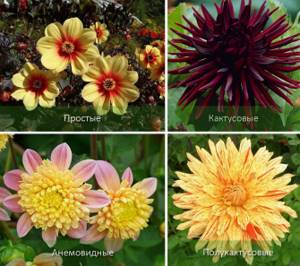
Painted in different colors except blue. The bushes are dense, with strong branches. Species bred: Viking, Little William Rocco, Amber Queen.
Cactaceae
Bush plant forming up to 15 flower stalks. The flowers are dense, 10 cm in diameter, with pointed petals in the form of needles. Used for growing in a group or individually. Black Wizard, Favorite, Princess Park, Blackbury look amazing.
Semi-cactus
Transitional group of medium asteraceae. It rises to a height of 130 cm, the foliage is lush. The inflorescences are double, large, partly tubular, pointed flowers. The best varieties: Meteor, Island Dilight, Papers Pink, Just Peachy,
Nymphaeal
Huge bushes, branched. Leaves are cut into several parts. The flower is 18 cm, resembles a water lily, consists of petals inclined towards the center. The roots are tuberous. Famous and popular types: Twinnie, Kens Flame, Rapallo.
Decorative
The largest class of dahlias with double flowers. Leaves are opposite. Flowering from July to September. The flowers bend towards the stem, which gives a stunning effect.
Planting tubers in open ground
In temperate latitudes, dahlias are not left inside the ground. For annual flowering, rhizomes are dug up in the fall, properly stored during the winter months, and then planted in the spring. This can also be done in two ways. For an earlier appearance of buds, root tubers are planted in large pots for germination, then placed in the ground. Or, immediately after the end of the threat of frost, they are planted in the garden.
This method of reproduction has advantages. The roots retain all the characteristics of the mother plant.
Preparing tubers for planting
Tubers are germinated in a greenhouse or at home on a windowsill, in prepared containers with soil treated as for seedlings. Before planting, the roots are inspected and dried ones are removed. Plant without deepening, leaving 3 cm above the surface, preferably with buds. When they begin to sprout, they are taken out of the ground, shaken off and divided with a knife, leaving one young bud on each part. The sections are treated with a biostimulant.
The separated parts are buried back into containers for further growth. If excess shoots appear, they are cut off and the cuttings are rooted in the ground. After the last cold weather, around the end of spring they are planted in the garden.
Prepare holes for planting every 60 cm in advance, add phosphorus, potassium, and magnesium. Tubers are placed in the soil so that only sprouted shoots are visible above the surface, and the roots are buried 5 cm.
Site selection
Dahlias are heat-loving and moisture-loving flowers. These properties are taken into account when choosing a site for planting. Find a place that is flat or slightly elevated, covered with plantings or buildings, and sunny. Flowers are not planted in lowlands. The soil must be fertile and breathable. If the soil is heavy, add sawdust, humus or sand. Dahlias like neutral or slightly acidic soil. Gardeners take care of soil deoxidation in the fall by adding slaked lime.
Flowerbeds are not made next to trees so that they do not take moisture from the dahlias.
Types of dahlias
Depending on the shape of the flower basket, dahlias can be double, semi-double or non-double. Each group of dahlias is divided into classes. At the moment, more than 12 thousand varieties of dahlias have been bred, differing in plant height, size, shape and color of inflorescences. Based on the shape of the inflorescences, dahlias are divided into 12 groups.
Dissected dahlias
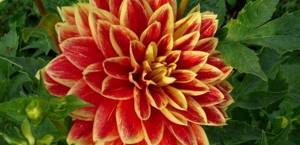
These are double dahlias with large and highly elongated reed flowers.
Cactus dahlias
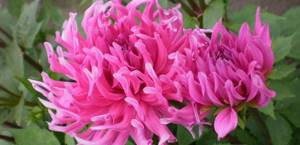
Terry dahlias have large reed flowers, the petals of which are rolled into a long narrow tube outward or inward.
Orchid dahlias
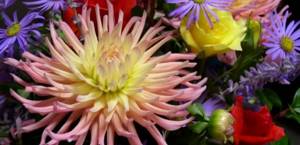
Double dahlias with large reed flowers, fancifully curled or extended outward.
Chrysanthemum dahlias
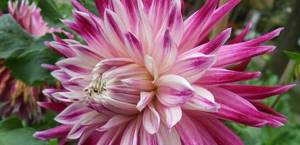
Dahlias, whose reed flowers are twisted into a curved tube, are shaped like chrysanthemums.
Pompon dahlias
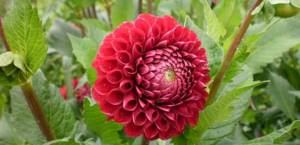
Double dahlias with short and dense reed flowers. Small inflorescences reach approximately 5 cm in diameter. This group is most often grown for cutting.
Peony dahlias
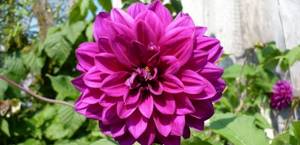
Dahlia flowers of this species have large reed flowers arranged in three rows, the inflorescence with an open center is similar to a peony flower.
Nymphaeum dahlias
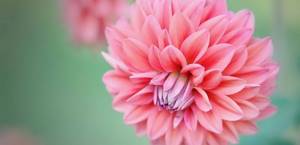
Dahlias, the inflorescences of which consist of slightly concave oval-shaped false-lingual flowers.
Anemoid dahlias
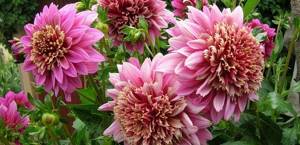
Dahlias with inflorescences shaped like an anemone. In the center of the inflorescence there is a disk consisting of tubular flowers, around which there are one or two rows of large reed flowers.
Dahlias Mignon
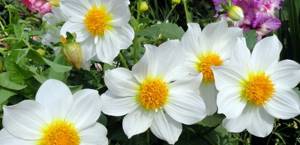
This group is also called non-double, or annual dahlias. Also known as dwarf dahlias, because they reach a height of 50 cm. Varieties with double and semi-double inflorescences, also belonging to the minion group, have also been bred.
Decorative dahlias
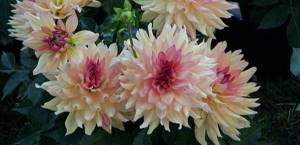
Dahlias with large double inflorescences with wide flower tongues. This group of dahlias consists of the following subgroups:
- giant, or gigantic - with huge inflorescences measuring 18 cm in diameter;
- large;
- average;
- small;
- miniature, whose inflorescences reach only 5 cm in diameter.
Collared dahlias
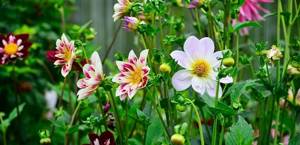
In the center of the inflorescences of these dahlias there is a disk of tubular flowers, around it there are 2-3 rows of petal-shaped flowers, which seem to form a kind of collar around the disk. Along the periphery of the inflorescence there are large reed flowers, different in color from the middle.
Globular dahlias
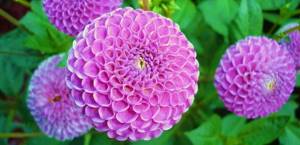
Terry dahlias with dense spherical inflorescences reach 15–20 cm in diameter. The petals of the flowers resemble a tube, expanding at the top. Some gardeners combine this group with pompoms.
Caring for dahlias
Dalia is cared for like any other planting. Periodically hill up the soil and get rid of weeds. Excess stems are pinched as they grow, achieving fullness of the bush. Some of the branches are cut off so that they do not interfere with air exchange, cuttings are cut from them and rooted. Removing weak shoots allows you to ventilate the bush to avoid infection with gray mold and fusarium diseases. Faded inflorescences break off.
Check periodically for diseases, as powdery mildew may appear during humid summers. To avoid troubles, potassium and phosphorus fertilizers and fungicides are applied.
Watering
Water every week, pouring 10 liters of water under the bush. Then, when the soil dries, it is hilled up.
Feeding
The first time is fed when planting flowers in the ground, then every 2 weeks, alternating mineral and organic fertilizers.
During feeding, add 15 g of ammonium nitrate, as well as superphosphate and potassium at the rate of 30 g per 10 liters. Manure, mullein or bird droppings, heavily diluted with water, are used as organic matter so as not to burn the roots. Add 1 liter for each plant.
Supports
Tall varieties of dahlias are tied to a trellis or a buried stick every 35-40 cm. Do not tighten the garter material too much so that it does not dig into the plant. They use ribbons, special wide fastenings, and cuttings from old rags. Wire and rope will not work.
How to dig up tubers and store dahlias in winter
The stems and leaves of dahlias droop at the first frost. Make a hole to a depth of about 30-40 cm from the main shoot, digging out the plant. The remaining soil is removed from the tubers, washed under running water, and dried for a month in a ventilated room at a temperature not exceeding +12 °C. Then they are treated against diseases and rot and removed until next summer.

The rhizomes are packaged in cardboard boxes or paper bags, or left in paraffin and a sand cushion in the cellar or vegetable compartment of the refrigerator. The substrate should be slightly moistened.
Root tubers are periodically inspected for damage and rot. Diseased specimens are destroyed.
Planting dahlias
The timing of planting dahlias in open ground depends on the climatic conditions of the area. In the middle zone, dahlias are planted in open ground after June 1-10 with grown plants. Dahlias can be planted earlier, as soon as the soil warms up sufficiently, from about May 15-20, with ungrown, divided tubers with clearly defined eyes. After two weeks, shoots appear from the ground. It is necessary to monitor the air temperature and cover the plants if there is a threat of frost.
Plants (both cuttings and those grown from divided tubers) are planted in pre-prepared areas with stakes placed and holes dug around them. The approximate distance between plants is set to half the height of an adult plant (from 60 to 100 cm in a row), the distance between rows is at least 100 cm. The stakes must be strong, 160-180 cm high. Coniferous stakes are more durable. To preserve them for a long time, it is necessary to impregnate the lower part of the stakes with special compounds, for example 7% iron sulfate, and paint the stakes themselves with green paint. Metal stakes are more durable and convenient. To do this, use old unusable pipes or pieces of reinforcing steel with a diameter of 12-20 mm. The stakes are driven to a depth of 40 cm. After this, a plant is planted closer to the stake (with water added to the hole) so that the neck of the tuber is 4-5 cm below the ground level.
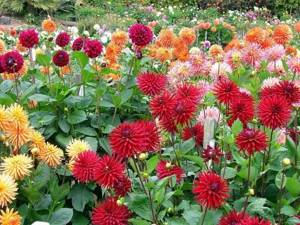
Cuttings and hybrid seedlings are usually planted deeper, up to 8-10 cm. It is better to plant cuttings with two plants for each stake. In this case, it is necessary to take into account plant growth. When planting dahlias on ridges in two or three rows, they try to select plants according to their height. Low varieties are planted in the first row, medium height in the second, tall and very tall varieties in the third, and the shape, color and size of dahlia inflorescences are also taken into account.
It is recommended to plant plants in cloudy weather or in the evening. Cuttings or plants grown from divided tubers are first heavily watered before planting, and then carefully, with a lump of earth, trying not to damage the plants or break the lump, they are planted in the prepared hole. Ring-shaped holes are made around the planted plants or the holes are left incompletely filled to ensure ease of watering. Later, when cultivating the soil, the hole is gradually leveled, and furrows are made for watering. Planted plants are immediately tied to stakes (depending on the height of the plant in 2-3 places or more). As the plants grow, the garter is continued. Immediately after planting, a label with the name (or number) of the plant is attached to the top of the stake.
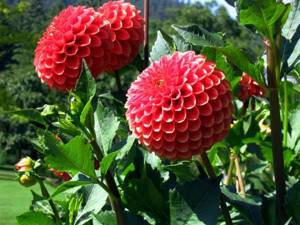
Perennial dahlias in landscape design, combination with other plants
Dahlia is the king of landscape design. Due to the richness of species and colors, it occupies a leading position in the creation of flowering mixborders. The splendor of its shapes and color palette allows it to be used in the design of monogamous compositions. Compact miniature bushes along sidewalks are good. Designers use different varieties to create flowering paths along green hedges. Low-growing specimens look beautiful on alpine hills and ridges. They decorate terraces and balconies.
Dahlias are unique because they combine with a variety of perennials. An ideal companion for lilies, irises, daisies, chrysanthemums, echinaceas, field poppies, lupins. Even the smallest dahlia, which has collected many varieties, evokes a lot of positive emotions. Open sunny areas are allocated for them, visible from all sides. Large-flowered specimens look impressive in small groups against the backdrop of lawns.
Landscape architects often use varieties that have decorative foliage in various rich shades, for example: dark cherry, red-brown, which emphasizes the beauty of bright inflorescences.
